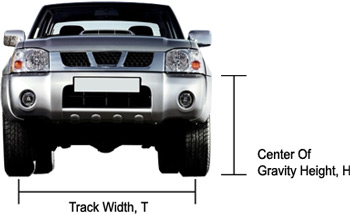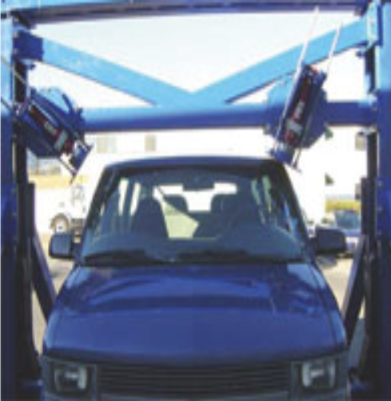Quasistatic Roof Strength Fixture Design and Testing (FMVSS 216, M216)
CfIR's research was instrumental in saving lives by providing NHTSA with experimental data and analysis that led to:
- 1. NHTSA's strengthening of the FMVSS 216 test criteria,
2. NHTSA's adoption of a 2-sided FMVSS 216 test,
FMVSS 216 Roof Crush Resistance Compliance Test:
- Scope: This standard establishes strength requirements for the passenger compartment roof.
Purpose: The purpose of this standard is to reduce deaths and injuries due to the crushing of the roof into the occupant compartment in rollover crashes.
 FMVSS 216/216A Rating System:
Safercar.gov publishes “star ratings” of U.S. vehicles in all accident modes. The rollover ratings are based on an SSF. The SSF of a vehicle is an at-rest calculation of its rollover resistance based on its most important geometric properties. The SSF is a measure of how top-heavy vehicle is. The SSF only tells you how likely it is for the vehicle to rollover, NOT how well the vehicle structure will hold up if it does roll!
FMVSS 216/216A Rating System:
Safercar.gov publishes “star ratings” of U.S. vehicles in all accident modes. The rollover ratings are based on an SSF. The SSF of a vehicle is an at-rest calculation of its rollover resistance based on its most important geometric properties. The SSF is a measure of how top-heavy vehicle is. The SSF only tells you how likely it is for the vehicle to rollover, NOT how well the vehicle structure will hold up if it does roll!
A vehicle's SSF is calculated using the formula SSF = T/2H, where T is the “Track Width“ and H is the “Height of the CG.” The track width is the distance between the centers of the right and left tires along the axle. The location of the CG is measured in a laboratory represents the height above the ground of the vehicle's mass. The lower the SSF number, the more likely the vehicle is to roll over in a single-vehicle crash.
Limitations of the FMVSS 216 Ratings: When evaluating a rating system based solely on FMVSS 216, in comparison to dynamic testing, anomalies abound. The Honda CRV is one such anomaly. The Honda CRV emulates the rollover roof crush performance of vehicles like the Volvo XC-90 and the VW Jetta with a high SWR. The Honda CRV may be a geometry-derived implementation of a roof improvement.
The U.S., European and Australian NCAP and the IIHS produce ratings of new vehicle performance based on dynamic crash tests in frontal, side and rear crashes, and vehicle handling tests. No dynamic-based crashworthiness ratings exist to date for new vehicle performance based on rollover crashes. There is no rating for rollover occupant protection, a crash mode responsible for one-third of all light vehicle occupant fatalities. NHTSA has upgraded the roof crush requirements for new cars, but the time is overdue for an NCAP rating on rollover survivability.
 CfIR Developed the Quasi-Static 2-Sided Roof Strength Fixture (M216): The M216 measures vehicle roof strength similar to FMVSS 216. However, CfIR test both sides of the vehicle roof sequentially at angles that more realistically emulate roof impacts. Our test procedure accounts for the fact that both sides of the roof contact the ground in multiple-roll accidents, and that the second side impact is at a greater roll angle than the first. By measuring roof strength on both sides we are able to quantitatively assess the amount of strength that the bonded windshield contributes to the roof as well as the gross disparity between first side and the second side roof strength (in the first roll of a multiple rollover). The fixture can also be used for glazing retention studies for ejection cases, analysis of roof strength for occupants injured in rear seat seating positions, and for measuring the roof strength of vehicles equipped with ROPS devices.
CfIR Developed the Quasi-Static 2-Sided Roof Strength Fixture (M216): The M216 measures vehicle roof strength similar to FMVSS 216. However, CfIR test both sides of the vehicle roof sequentially at angles that more realistically emulate roof impacts. Our test procedure accounts for the fact that both sides of the roof contact the ground in multiple-roll accidents, and that the second side impact is at a greater roll angle than the first. By measuring roof strength on both sides we are able to quantitatively assess the amount of strength that the bonded windshield contributes to the roof as well as the gross disparity between first side and the second side roof strength (in the first roll of a multiple rollover). The fixture can also be used for glazing retention studies for ejection cases, analysis of roof strength for occupants injured in rear seat seating positions, and for measuring the roof strength of vehicles equipped with ROPS devices.
